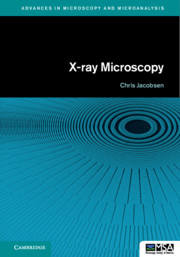Book contents
- Frontmatter
- Contents
- Contributors page
- Foreword
- 1 X-Ray Microscopes: a Short Introduction
- 2 A Bit of History
- 3 X-Ray Physics
- 4 Imaging Physics
- 5 X-Ray Focusing Optics
- 6 X-Ray Microscope Systems
- 7 X-Ray Microscope Instrumentation
- 8 X-Ray Tomography
- 9 X-Ray Spectromicroscopy
- 10 Coherent Imaging
- 11 Radiation Damage and Cryo Microscopy
- 12 Applications, and Future Prospects
- Appendix A X-Ray Data Tabulations
- References
- Index
7 - X-Ray Microscope Instrumentation
Published online by Cambridge University Press: 28 October 2019
- Frontmatter
- Contents
- Contributors page
- Foreword
- 1 X-Ray Microscopes: a Short Introduction
- 2 A Bit of History
- 3 X-Ray Physics
- 4 Imaging Physics
- 5 X-Ray Focusing Optics
- 6 X-Ray Microscope Systems
- 7 X-Ray Microscope Instrumentation
- 8 X-Ray Tomography
- 9 X-Ray Spectromicroscopy
- 10 Coherent Imaging
- 11 Radiation Damage and Cryo Microscopy
- 12 Applications, and Future Prospects
- Appendix A X-Ray Data Tabulations
- References
- Index
Summary
Janos Kirz and Michael Feser contributed to this chapter.
The first x-ray microscopes were one-of-a-kind instruments that were operated by their builders, in a tradition that continues to this day. Although there was a brief phase in the 1950s where commercial point-projection microscopes were available (see Section 6.2, and [Cosslett 1960, Plates IX.B and X]), up until the year 2000 essentially all microscopes were custom-built. These custom-built microscopes are now joined by commercial instruments offering a wide range of capabilities. No matter whether you are using a commercial instrument where you can pop a sample in and push a button to get an image, or a custom instrument, it is useful to understand what “makes it tick.” Hence this chapter. Section 7.1 discusses x-ray sources, while Section 7.2 discusses the optical transport systems and associated equipment needed to bring the x-ray beam to the imaging system. After some brief comments on nanopositioning systems in Section 7.3, the properties of several types of x-ray detectors are covered in Section 7.4. Finally, Section 7.5 provides a short introduction to specimen environments.
The degree of sophistication in modern x-ray microscopes is worth a moment's pause for thanks. It wasn't always so! What is available today makes the home-built system (Fig. 2.4) that the author first encountered look unbelievably crude, and at that point things had already made significant advances from earlier years [Kirz 1980c, Rarback 1980]. An amusing anecdote was presented by Arne Engström in 1980 [Engström 1980] as he looked back on four decades of work in x-ray microscopy:
Another trend in x-ray microscopy and x-ray microanalysis, especially in the field of the biomedical sciences, is the increasing sophistication and complexity of systems and equipment for the collection and treatment of experimental absorption data. However, this trend is not unique to this field of research. In fact, over the last 20 to 30 years there has been such a fantastic development of commercially available instrumentation for research and development that, in retrospect, the immediate post-war conditions seems very primitive indeed. For example, I remember the presentation of an automatic recording optical microabsorptiometer applicable to cellular analysis at an AAAS meeting in Boston in 1951.
- Type
- Chapter
- Information
- X-ray Microscopy , pp. 259 - 320Publisher: Cambridge University PressPrint publication year: 2019

